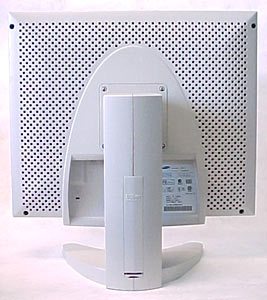While the quality of
the LCD panel and back light is obviously the most important point of any flatscreen display,
there are still a few external aspects that can make or break a
unit as a whole.
No matter
how amazing the image quality
is on a display, if you cannot adjust the the
entire monitor to suit your position it won't be of much long lasting
use. The movements of the 800TFT are generally subdued, partially due to the size
of the unit, and partially due to its' intended purpose. Unlike smaller TFT displays
the front to back rotation of the panel on the
included stand is small, about 5 degrees forward and 15 degrees back -
sufficient for desk work.
The stability of the
base supporting the precious TFT panel is a prime concern for the longevity any
display - tipping is not good. The base on the 800TFT has a wide stance to
support the
LCD panel. The base even has an integrated lazy-susan so the entire
unit can be rotated horizontally with just one hand. The unit rotates as a one
piece unit so the stand is always in the right orientation to support the heavy LCD
panel.
We looked at a 15" Hitachi display
previously which was rather unique in that its' support
stand had a joint enabling it to rotate without moving the entire
base-plate. That would be tricky to pull off with a flatscreen of this size. For
proper support in each direction, the base would probably have to be quite
large - taking up too much desk real estate to really be worth while.

As with a few TFT
display we've looked at, the
800TFT comes with an integrated Kensington security
lock. The small locking hole is something you
might be more accustomed to see on a notebook. Since the locking hole is positioned on the
rear of the display panel it remains out of the way, and for the most part out
of sight for relatively subtle security.
 Apart from the space in the rear of the stand for a USB
hub, one of the cooler features of
the 800TFT, or for that matter most versatile flatscreens is the ability to completely remove the stand
for wall mounting. Four screws hold the stand onto the panel.
Apart from the space in the rear of the stand for a USB
hub, one of the cooler features of
the 800TFT, or for that matter most versatile flatscreens is the ability to completely remove the stand
for wall mounting. Four screws hold the stand onto the panel.
Leading into the panel are the DC power source,
Analog video input (15-pin D-Sub) and Sun 13W3 connector we mentioned before.
The Sun 13W3 connector sets the 800TFT apart from most anything else
by enabling high-end Sun and SGI system users to adopt a flatpanel display
without the need for any adapters.
The all important Front
Bezel:

The front bezel is
where the main controls for
the monitor are located. Ideally the most frequently used buttons are right up front.
With displays these days having many, many user definable options and adjustments, including a button
for every possible setting on the bezel is just not feasible.
On the front of the 800TFT are the power, contrast, brightness,
exit, A/B and auto adjustment keys. The auto adjustment key being the most
important. Depressing this button will trigger the display to adjust itself to the
perfect settings. These settings can be adjusted by hand if necessary, but the
auto key is really a time saver. Most LCD flatscreens have this key up front
and center, and some CRT's are even starting to follow suit.
